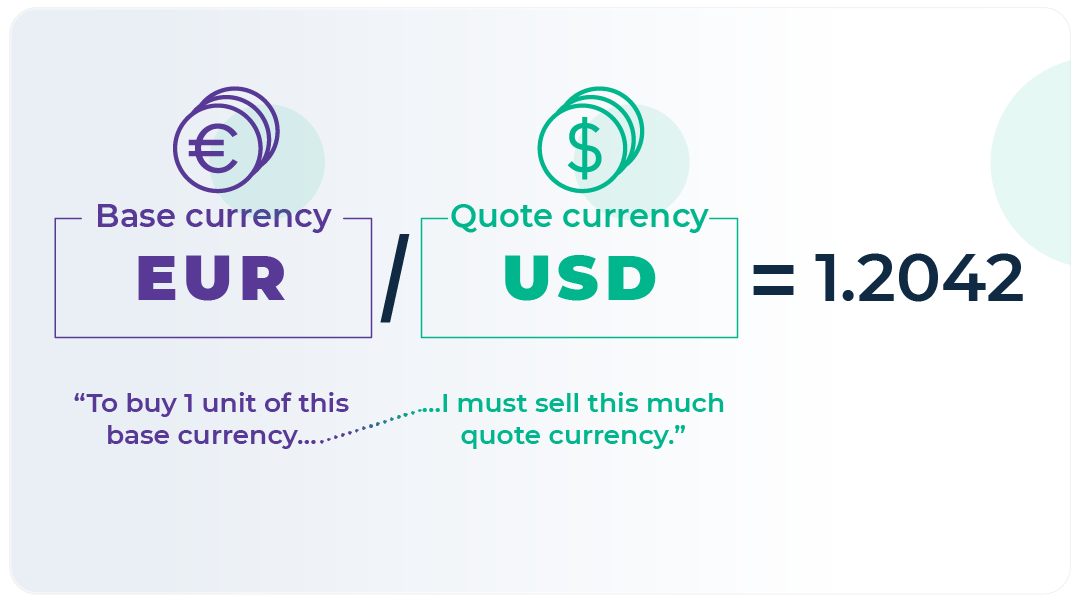The base currency is the first currency shown in a foreign exchange quotation. The second currency in the quotation is called the quote currency, or counter currency.
Foreign exchange quotations are always presented as a currency pair in the following format: XXX/YYY e.g. EUR/USD. This is because, when you exchange currency, you’re selling one currency and buying another.
The exchange rate represents how much quote currency you need to sell in order to buy one unit of the base currency.
Let’s say you’re a business based in New York City, and your supplier in Paris sends you an invoice totalling €3,000. You’ll need Euro to settle this invoice.
As you don’t have any Euro handy, you’ll need to sell US Dollars to buy Euro. So you go online to obtain a foreign exchange quote.
The quote looks like this: EUR/USD 1.20.
In this example, the Euro is the base currency and the US Dollar is the quote currency. The exchange rate tells you that you need to sell $1.20 to buy €1. So you’ll need to sell $3,600 to buy the €3,000 you need to settle your Parisian supplier’s bill.
Foreign exchange quotes can be either direct or indirect.
In a direct quote, the base currency is a foreign currency while the quote currency is the local currency. So, in our example, the quote is direct, because the quote currency — US Dollars — is your local currency.
In an indirect quote, on the other hand, the base currency is the local currency and the quote currency is a foreign currency. So if you’re in the UK and your quote to exchange money into Euro is shown as GBP/EUR, for instance, this would be an indirect quote.
ANATOMY OF A FOREIGN EXCHANGE QUOTATION
Currency markets are always quoted in pairs because you’re always selling one currency to buy another currency.

Some Facts
- Whether foreign exchange quotes are direct or indirect largely depends on convention. Most countries use direct quotes, because they’re easier to understand — a direct quote tells you how much of your local currency you need to buy a foreign currency. But the UK, Australia, New Zealand, and Canada typically use indirect quotes.
- The three-letter codes that represent a specific currency in a currency pair are prescribed by ISO — the International Organisation for Standardisation — in standard ISO 4217. The codes are published in three tables:
- Table A.1 lists the codes of currently active currencies and funds
- Table A.2 lists the codes of currently active funds
- Table A.3 lists the codes of currencies and funds codes that are no longer in use
- Most currency codes follow the same format: the first two letters are the official ISO country code, and the last one is the first letter of the currency’s name. So in USD, for instance, US stands for United States while D stands for Dollar.
There are a number of notable exceptions. The Euro’s code is EUR, not EUE. Similarly, the Mexican Peso’s code is MXN, not MXP. And the Russian Ruble’s code is RUB, not RUR.
In Mexico and Russia’s case, this is because MXN and RUB have replaced currencies that had the same name, so the codes are slightly different to avoid confusion. In the Euro’s case, EUR was chosen because it rolls off the tongue more easily and is more memorable than EUE.
Want to know more?
- If you’re in a rush, this video explains currency pairs and the difference between base currency and quote currency in just under one minute.
- With an average trade volume of $2.9 trillion a day, the US Dollar is the most traded currency in the world. This article explains its history and role in the global economy, including the story behind how it came to be the world’s most important currency.
ALT21’s perspective:
“Currency pairs fluctuate all the time for many reasons — supply and demand, economic indicators, political stability… the list goes on. If you exchange one currency for another often, for example because you depend on suppliers in another country, hedging techniques like spots, options, and futures can give you more certainty and help minimise your risk of being negatively affected by these fluctuations.”


